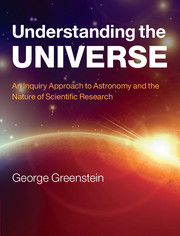Book contents
- Frontmatter
- Contents
- Preface
- Acknowledgments
- Part I Introducing steps to astronomy
- 1 The sky
- 2 The origins of astronomy
- 3 Newton's laws: gravity and orbits
- 4 Light
- 5 The astronomers’ tools: telescopes and space probes
- Part II The Solar System
- Part III Introducing stars
- Part IV Introducing galaxies and the Universe
- Epilog
- Appendix I The small-angle formula
- Appendix II Exponential notation
- Appendix III The Solar System
- Appendix IV The closest and brightest stars
- Appendix V Physical and astronomical constants
- Appendix VI Conversion factors
- Appendix VII Constellation maps
- Glossary
- Figure Credits
- Index
- Plate section
3 - Newton's laws: gravity and orbits
from Part I - Introducing steps to astronomy
Published online by Cambridge University Press: 05 February 2013
- Frontmatter
- Contents
- Preface
- Acknowledgments
- Part I Introducing steps to astronomy
- 1 The sky
- 2 The origins of astronomy
- 3 Newton's laws: gravity and orbits
- 4 Light
- 5 The astronomers’ tools: telescopes and space probes
- Part II The Solar System
- Part III Introducing stars
- Part IV Introducing galaxies and the Universe
- Epilog
- Appendix I The small-angle formula
- Appendix II Exponential notation
- Appendix III The Solar System
- Appendix IV The closest and brightest stars
- Appendix V Physical and astronomical constants
- Appendix VI Conversion factors
- Appendix VII Constellation maps
- Glossary
- Figure Credits
- Index
- Plate section
Summary
We have not yet finished our survey of the origins of astronomy. With the work of Isaac Newton (1642–1727) we reach the culmination of the scientific revolution. Because the laws he set forth are so central to an understanding of astronomy, we will devote an entire chapter to them.
Gravitation is the single most important factor that determines the structure of the astronomical Universe. There is not a single aspect of astronomy for which gravity fails to play a crucial role. Newton codified the idea that gravitation is a force, and he gave a formula describing its strength. According to his formula, every body in the Universe exerts a force of gravitational attraction on every other, the strength depending on their masses and the distance between them. He also created laws describing what happens to a body when a force acts upon it, his famous three laws of motion.
The theory Newton created more than three centuries ago is still the backbone of much of our understanding of the cosmos. It describes the orbits of the planets about the Sun and of stars in the Galaxy, the force compressing a star to thermonuclear temperatures and the force that governed the slow process of amalgamation whereby the Earth was formed. And it guides our engineers today as they plot the paths our space probes will take on their journeys to the distant reaches of the Solar System.
- Type
- Chapter
- Information
- Understanding the UniverseAn Inquiry Approach to Astronomy and the Nature of Scientific Research, pp. 63 - 88Publisher: Cambridge University PressPrint publication year: 2013



